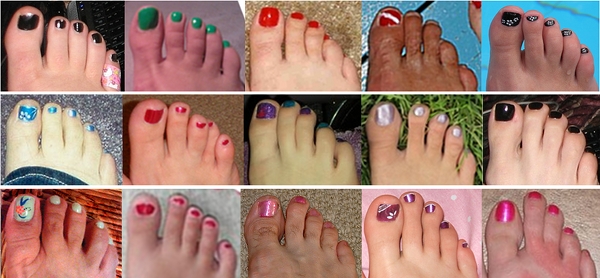Toe length: The myth
In some people, the big toe is longer than the second toe (here called "L," for long big toe), while other people have the big toe shorter than the second toe ("S"). This is sometimes said to controlled by one gene with two alleles, with the allele for S dominant to the allele for L. There is no good evidence for this myth; the small number of studies of toe length give contradictory results.
 |
| Toes ranging from big toes longer (upper left) to big toe shorter (lower right). |
The reality
Toe length as a character
I did an image search for painted toenails and arranged the images from longer big toes to longer second toes. As you can see, the relative length of the big and second toes varies continuously; there aren't just two categories of toe length. Some studies have found about 5 percent of the populations sampled to have the big toe and second toe equal in length (Romanus 1952, Turgut et al. 1997). Hawkes (1914) said the big and second toes were the same length in only 0.1 percent of people. She also said about 6 percent of people had the big toe longer on one foot and the second toe longer on the other foot.
Family studies
Hawkes (1914) compared British parents and offspring, with the following results (individuals who were L on one foot and S on the other are omitted):
| Parents | S offspring | L offspring |
|---|---|---|
| S x S | 8 | 1 |
| S x L | 10 | 58 |
| L x L | 0 | 154 |
She concluded that L was "irregularly dominant" over S. In reality, these data are consistent with S being dominant over L. If L were dominant, some of the L x L matings would be of two heterozygotes, and some of their offspring would be S.
Beckman et al. (1960) compared Swedish parents and offspring, with the following results:
| Parents | S offspring | L offspring |
|---|---|---|
| S x S | 3 | 1 |
| S x L | 6 | 31 |
| L x L | 3 | 56 |
While there is clearly a genetic component, the one L offspring of S x S parents does not fit the model of S being recessive, while the three S offspring of L x L parents do not fit the model of S being dominant.
Papadopoulos and Damon (1973) performed a similar study on four tribes in the Solomon Islands:
| Parents | S offspring | L offspring |
|---|---|---|
| S x S | 74 | 46 |
| S x L | 63 | 102 |
| L x L | 51 | 137 |
In this study, S parents are more likely to have S offspring than are L parents, so there seems to be some genetic influence on toe length. However, if the myth were true, two S parents could not have an L child, yet more than a quarter of the children of S x S matings are L. The large number of S individuals with two L parents is inconsisent with the myth that this is a simple one-gene, two-allele genetic character, with S completely dominant to L. The difference between the results from Great Britain, which fit the simple two-allele model, and the results from the Solomon Islands is puzzling; it is possible that the genetics of toe length are just more complicated in the Solomon Islands than in Great Britain.
Twin studies
Kaplan (1964) found that out of 63 pairs of monozygotic twins, none had one L twin and one S twin, while 11 out of 44 pairs of dizygotic twins had one L and one S twin. This clearly indicates a strong genetic influence on this trait, although it does not indicate whether toe length is controlled by one or more than one gene.
Conclusion
Whether the big toe is longer or shorter than the second toe is influenced by genetics, but it may be determined by more than one gene, or by a combination of genetics and the environment. You should not use toe length to demonstrate basic genetics.
References
Beckman, L., J.A. Böök, and E. Lander. 1960. An evaluation of some anthropological traits used in paternity tests. Hereditas 46: 543-569.
Hawkes, O. A. M. 1914. On the relative lengths of the first and second toes of the human foot, from the point of view of occurrence, anatomy and heredity. Journal of Genetics 3: 249-274.
Kaplan, A. R. 1964. Genetics of relative toe lengths. Acta Geneticae Medicae et Gemellologiae 13: 295-304.
Papadopoulos, C. C., and A. Damon. 1973. Some genetic traits in Solomon Island populations. III. Relative toe lengths. American Journal of Physical Anthropology 39: 185-190.
Romanus, T. 1952. Frequency of long second toe in Swedish children from Uppland province. Acta genetica 3: 159-167.
Return to John McDonald's home page
This page was last revised December 8, 2011. Its address is http://udel.edu/~mcdonald/mythtoelength.html. It may be cited as pp. 61-63 in: McDonald, J.H. 2011. Myths of Human Genetics. Sparky House Publishing, Baltimore, Maryland.
©2011 by John H. McDonald. You can probably do what you want with this content; see the permissions page for details.
